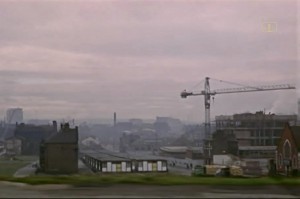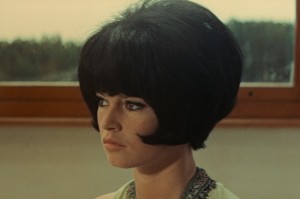The Invisible City: The Cinema Of Surveillance
In this essay commissioned by Heart of Glass, Laura Robertson considers what cinema has to teach us about the sinister implications of surveillance in domestic and corporate life. What is our awareness and understanding of surveillance today? And have our attitudes towards it changed at all since the 1950s?
“We’ve become a race of Peeping Toms”, scolds Stella. “What people ought to do is get outside their own house and look in for a change. Yes sir. How’s that for a bit of homespun philosophy?” Stella is a visiting home nurse, played by Thelma Ritter in Alfred Hitchcock’s 1954 thriller Rear Window. She is a brusque, practical character, and a foil to her patient: professional photographer and “Peeping Tom” L.B. Jeffries (James Stewart, pictured, below). Jefferies is wheelchair-bound after breaking his leg and is riddled with boredom; much to Stella’s disapproval, he begins to watch his neighbours for entertainment. Seated in his Greenwich Village apartment, Jefferies is afforded a fabulous courtyard view into the lives of others. Opposite, “Miss Torso” rehearses dance routines in her kitchen; “The Newlyweds” draw the blinds on a steamy honeymoon; “Songwriter” struggles to compose at his piano; “Miss Lonelyhearts” partakes in a disastrous date… and Lars Thorwald’s ill wife goes missing after they have an argument. Has she been murdered?
Stuck in a leg cast, Jeffries is vulnerable; he embodies a universal fear of being caught looking. As we might (we see through Jefferies eyes), he switches off the lights to be better able to see Thorwald, himself unobserved (he hopes). He embarks on a surveillance, or close observation, of Thorwald; enthusiastically recruiting a reluctant Stella, and his high society girlfriend Lisa Freemont, to watch and investigate with him. Three amateur sleuths discuss the what and hows and whens and whys of the imagined murder. Despite being warned off by a disbelieving detective, (spoiler alert) the women eventually break into the suspect’s apartment to search for evidence, watched by an anxious Jeffries, and watched by us. But as Thorwald returns early with Freemont still there, will she be caught out? And by whom: a callous murderer, or an innocent man?
It is a dizzying exchange of looking and being looked at: from our comfortable perspective in the cinema seat, from Hitchcock’s directorial chair, from behind the camera, and from within the film itself: Jefferies spying on Thorwald, and Thorwald’s realisation of being spied upon, and eventually spying right back. Significantly analysed in film theory, Rear Window is a good example of the power of “the gaze”; in the act of looking steadily and intently at another, we can claim power over another — especially when the watched do not know they are being watched. This idea was infamously outlined by philosopher Michel Foucault (1926–1984), who proposed: “The gaze that sees is the gaze that dominates and masters.” Whilst Foucault was talking about the mechanisms of power through the gaze (and its wider implications), it is clear that Hitchcock understood the political and social power of watching. Where we might otherwise have been left with an ethical dilemma – is it morally reprehensible to snoop, even if we suspect a crime? – in Rear Window, our surveillance is ultimately justified. Jefferies proves that Thorwald is guilty, and the murderer is captured by police. The voyeurs are vindicated; we sigh a breath of relief. But what does this film say about our awareness and understanding of surveillance? And have our attitudes towards it changed at all?
Hitchcock’s superbly tense murder mystery frequently tops critics’ film lists, and was an astute choice for a week-long immersive event about watching and being watched by Heart of Glass and Abandon Normal Devices Festival. In November 2016, The Invisible City: The Cinema of Surveillance devised a number of film screenings and performances in a place where watching was actively encouraged: the former Pilkington Glass Headquarters in St Helens. What better place to talk about surveillance than at the site of a glass factory? Now owned by a management company, Pilkington HQ is a quiet, concrete maze of grey buildings and car parks designed around a huge landscaped lake and green space. In its heyday, we would have witnessed a bustling 25,000 employees in the business of making glass for use in buildings and vehicles. Now, and especially at night, it is an eerie, silent zone of former commerce. Wood-panelled corridors that used to ferry thousands of workers into offices and onto factory floors now echo with the solitary footsteps of the occasional (watching) security guard. Windows look out onto the still lake. It is the perfect stage on which to imagine thrilling stories of espionage and Big Brother. The evening screenings, of which Rear Window was the main feature, were projected onto the walls of a four-storey courtyard – what else? – with audience members seated in parked cars and an old canteen. The viewer became the voyeur; physically simulating Jefferies’ actions, we sat watching in the dark. We could see, but could not be seen. Pilkington’s courtyard became Greenwich Village; silhouettes appeared behind windows watering plants, arguing, packing suitcases. Some viewers, as Jefferies did with his zoom lens, used binoculars to get a better look.
The memory that predominantly lingered after The Invisible City: The Cinema of Surveillance was Stella’s accusation of being a race of Peeping Toms; and more crucially, how this one line of dialogue prompted thoughts of how we’ve become better at it and more complicit. Rather than being ashamed about the ethics of snooping 60 years after Hitchcock’s influential work – or later, more critical films about watching, like The Conversation (1974), Red Road (2006), or 1971 (2014) – our methods of and addiction to observation have become terrifyingly effective, precise and wide-ranging, within the corporate and personal realms. Amid the exposure of mass surveillance at government and military level rather belatedly becoming part of public discussion, so too is our active participation in everyday surveillance. We are slap-bang in the middle of Foucault’s age of “infinite examination”. Reticence has turned into enthusiasm. Ready to donate our private information in exchange for a life online – openly sharing vital stats, constantly updated location, relationship status, innermost feelings, failures and triumphs – we have become addicted to other people’s lives, and exposing our own.
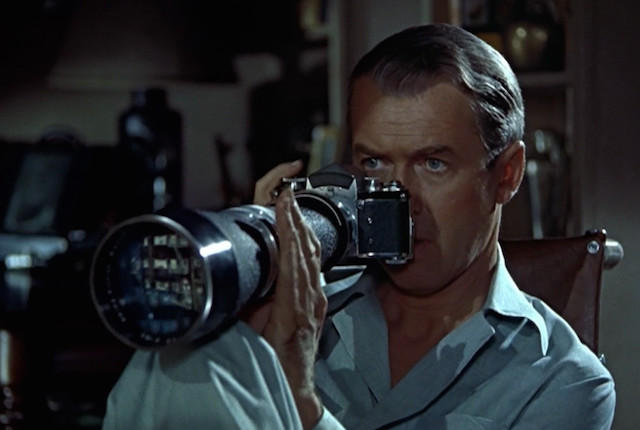
This is, of course, thanks to huge developments in technology. Imagine a 2017 version of Rear Window, which would more than likely utilise widely-available and affordable recording and surveillance equipment. In the 2007 remake Disturbia, protagonist and juvenile criminal Kale Brecht (Shia LaBeouf) has his movements restricted not with a leg cast, but under a house arrest; wearing an ankle monitor that connects to a proximity sensor. In the final scenes, he is filmed talking about his escapade with the serial killer next door, the results of which will be posted on YouTube. Ten years on, the technology is more extensive. Jefferies would undoubtedly take photos of Thorwald in real-time on his smartphone and send them to Stella on Snapchat. He might check when Thorwald’s wife had last logged into Facebook; would be more able to predict the timings of the suspect’s comings and goings with Google Maps. Lisa might live-stream her break-in with Periscope.
In Foucault’s 1975 book Discipline and Punish: The Birth of the Prison, he discussed politicised technologies: “Total surveillance is increasingly the general condition of society as a whole.” If so, then Rear Window’s natural cinematic successor would embrace technology and perhaps showcase a shrewder cast. They would be familiar with the constant possibility of being watched. They would be more ready to resist and subvert it. Taking control of their environment – and their omnipresent corporate observers – are the protagonists of Where The City Can’t See (2016), which premiered at The Invisible City: The Cinema of Surveillance. Directed by speculative architect Liam Young from a screenplay by author Tim Maughan, it depicts an imagined near-future where a factory town, not dissimilar to St Helens, is entirely managed by robots, whose surveillance footage is observed from afar by foreign investors. It may not be Foucault’s Panopticon prison – in which one guard is able to observe all inmates at any time – but this nightmare city employs the same threat: its inhabitants are less likely to break the rules if they believe they are being recorded, even if they are not.
Dedicated to making cars for their employers by day, the young factory workers in Where The City Can’t See hack the systems by night. Avoiding facial recognition tech by wearing camouflaged masks and cloaks, they run riot through “the spaces the city can’t see”. They hack taxis so their destinations can’t be monitored. They host illegal raves in presumably out-of-bounds areas of green space; edgelands that creep up against buildings and roads, tapering off into deep forest. In doing so, our protagonists avoid some of the oppressive monitoring systems utilised by their employers, gaining a temporary freedom from surveillance.
Startlingly, Where The City Can’t See has been filmed entirely with the scanning technologies used in autonomous cars. Like the archetypal Ghost in the Machine (referring specifically to the way in which philosopher Gilbert Ryle‘s description of consciousness theory has been depicted in popular culture, as in Arthur C. Clarke‘s malevolent computer HAL 9000 in his 1968 novel 2001: A Space Odyssey, and Stanley Kubrick’s film of the same year), we watch through the eyes of (possibly conscious) machines. As the world’s first narrative fiction film to be shot with LiDAR scanning technology, the aesthetic is exquisitely glitchy. The camera shots are in high definition; the movements might have been directed from a remote satellite. Pixelated street scenes are coloured with an artificial palette of concrete greys, greens and hot pinks, inspiring thoughts of roadside weeds and graffiti.
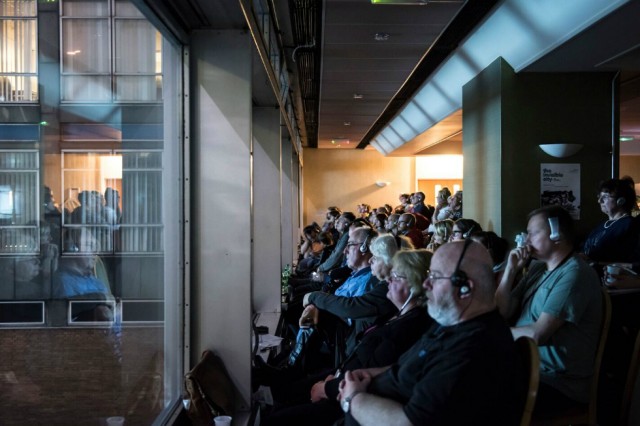
Whereas Rear Window’s concerns are more domestic, the overall concerns of The Invisible City: The Cinema of Surveillance were industrial, and heavily referencing its venue. The corporate spy in Where The City Can’t See is real; we are reminded that 21st century factories apply similar methods. Last year, Time Magazine reported that retail giant Amazon “shows clips of workers stealing various objects on giant TV screens” to discourage theft; they also flash the words “’terminated’ or ‘arrested’ on the screen to show each worker’s fate.” Likewise, The Guardian has compared the employees of Sports Direct to “Georgian-era factory workers”:
“The wall [of the very first factory] was to prevent people seeing in. The clock was to remind workers that their body clocks would be over-ridden by machine rhythms. And the cannon was there to prevent the local population storming the premises and tearing it to pieces. Today’s equivalents needn’t be so crude. Instead of the cannon and the clock, you have the camera in the cab of the truck driver; the GPS transmitter on the arm of the warehouse worker, tracking their speed and movement as they shift parcels; the barcode a home-care worker has to scan as she enters and leaves a client’s home in strictly timed 15-minute slots.”
Factories and their workers have been a focus of surveillance since the earliest film cameras were tested. Leaving Messrs Pilkington Bros Works, St Helens (BFI/1901) — a choice for the short film programme that preceded Rear Window and Where The City Can’t See — we watch a steady stream of men and boys in identical wool suits pour out of a doorway. The film is silent, but one can imagine that the factory whistle has just blown, ringing out across town; an important indicator of the working day’s end. Some spot the camera and stop and stare, entranced. Women and girls, with fraying shawls covering their heads, laugh and skip out of the door. One young woman in a hat stops still, directly in front of the camera’s gaze and faces it head on, neither defiant or excited. Could she, or her employers, imagine the implications of CCTV and GPS in today’s factory? Would they care? Would they protest these new tools of surveillance, with their profound consequences on the worker?
In his 2013 essay for Time and Motion: Redefining Working Life, FACT (Foundation for Art and Creative Technology) director Mike Stubbs states: “As our future world of work involves hybrids of network, database and communication skills, traditional roles such as clerical and office work become further vulnerable. As manufacturing represents only one in ten jobs in the USA and is increasingly automated with industrial robots, this starts to show a trend that productivity continues to grow while employment diminishes.” With this in mind during The Invisible City: The Cinema of Surveillance, it was performance artist Michelle Browne who was tasked to give some context. She used her skills as a storyteller to weave together the complex threads of surveillance, working life, and social responsibility. Browne devised a quasi-fictional tour of Pilkington Headquarters (pictured, below), and in painting a picture of what it was like to work there, she powerfully and movingly chronicled the human impact of employment evolution since the 1700s to the present day. Not from the industrialists’ point of view, but uniquely from the people who experienced the harshest end of the stick.
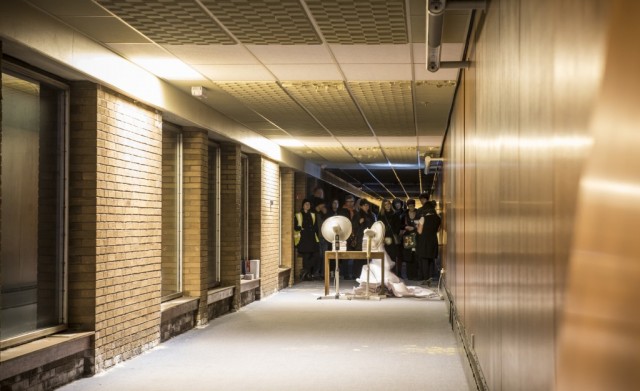
Leading us past dusty blinds and over dappled blue carpets, Browne embodied a female worker who didn’t age: “I’ve worked here, in one form or another, for a long time. At the beginning, I was on the factory floor. I cleaned, I packed, I did what I could; I did what I was allowed to do as a woman.” The Pilkington Brothers brought in “big machines” in the 1800s “that could do all sorts of things. It was really incredible; it seemed like they had a mind of their own.” But the machines weren’t the only things to change. People had to re-train to operate them; there were pensions to think about, distant bosses, longer hours, fewer holidays, redundancies (“Redundant was to become a word that was all too familiar over the years”). Employers demanded proof of “core competencies”. Efficiency was improved by outsourcing. “Go-getters” were rewarded. Some employees were tasked to collect data on their colleagues; there was a surveillance of phone calls and emails. “You’re being watched”, said Browne, “but you’re also watching.” As she is faced with her own brother’s redundancy – instructed to sort and post notices of termination – the wheels metaphorically come off. Browne’s character is angry and resistant. “I, like my brothers before me, would like to be the architect of change; whereby people can control their own lives.”
Browne presented us with an envelope, and therefore a dilemma. In a boardroom, we opened our post to find a form entitled Test For Personal Entrepreneurial Competencies: we were to rate a series of statements about our workplace skills and abilities. A jolly promotional film, Glass Research Aka Pilkington Glass Works (1959), played on a television in the background. We were now part of the Pilkington workforce; all attempts at passive participation were unacceptable. Would we fill in the form, or rebel against our imagined employers? Lulled into a state of obedience, some of the audience hesitated. Some turned the page over to find black lines in the shape of an arrow – instructions on how to make a paper aeroplane. And thus, the moment of rebellion came; an internal decision manifested in a flurry of paper planes and laughter. We chose to step out of the job, and therefore, temporarily out of the system. It was easy for us, as we weren’t really being made redundant. But there had been real employees faced with the same decision, and an uncertain future.
But is any form of rebellion against the omnipotent Peeping Tom futile? Are we so thoroughly dominated by Foucault’s dominant, all-seeing eye that we can’t escape it? After Browne’s tour, we stepped back out into the world, and the public spaces of surveillance. Although not as sophisticated as the futuristic streets of Where the City Can’t See, the streets of Britain in 2017 are nevertheless interspersed with CCTV. Inside and outside of the contemporary factory, we are exposed to the scrutiny of the authorities and of others. This is a pessimistic outlook. Perhaps what The Invisible City: The Cinema of Surveillance was most proficient at doing was highlighting the internal anxieties associated with surveillance, and questioning what – if anything – we might do about it. In an industrial setting echoing with the real lives and experiences of thousands of local people, we were afforded the time to reflect. Watching Rear Window in the dark, we put ourselves in a position to query the defining principles of right and wrong – and experienced the thrill of being caught looking. During Where The City Can’t See, we interrogated the ethics of mass monitoring, and sought to subvert its reach. Side-by-side with Browne, we could choose to participate in a surveillance culture that was disempowering to others, or to momentarily resist it; and we knew the implications of our choices. In essence, we got outside of our own houses and looked in for a change.
Laura Robertson
This essay has been commissioned by Heart of Glass: an agency for collaborative and social arts practice based in St Helens
Laura saw The Invisible City: The Cinema of Surveillance at Alexandra Park, formerly Pilkington HQ, 7–12 November 2016. Watch the documentary film here (3:04)
Where The City Can’t See (2016) is commissioned by Abandon Normal Devices and Heart of Glass & University of Salford Art Collection. Produced by Liam Young and Abandon Normal Devices, with support from Forestry Commission England’s Forest Art Works and funding from Arts Council England




